Animal models of choroidal and retinal neovascularization
- PMID: 20488255
- PMCID: PMC2962694
- DOI: 10.1016/j.preteyeres.2010.05.003
Animal models of choroidal and retinal neovascularization
Abstract
There have been numerous types of animal models of choroidal neovascularization (CNV) and retinal neovascularization (RNV). Understanding the pathobiology of CNV and RNV is important when evaluating and utilizing these models. Both CNV and RNV are dynamic processes. A break or defect in Bruchs' membrane is necessary for CNV to develop. This may be induced with a laser, mechanically via surgery, or in the setting of transgenic mice. Some of the transgenic mouse models spontaneously develop RNV and/or retinal angiomatous proliferation (RAP)-like lesions. The pathogenesis of RNV is well-known and is generally related to ischemic retinopathy. Models of oxygen-induced retinopathy (OIR) closely resemble retinopathy of prematurity (ROP). The streptozotocin (STZ) rat model develops features similar to diabetic retinopathy. This review summarizes general categories and specific examples of animal models of CNV and RNV. There are no perfect models of CNV or RNV and individual investigators are encouraged to choose the model that best suits their needs.
Copyright © 2010 Elsevier Ltd. All rights reserved.
Figures

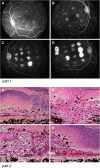
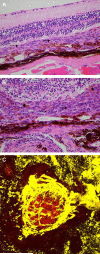

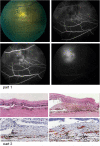


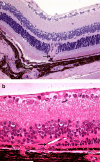
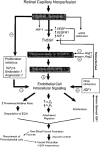

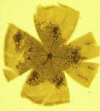

Similar articles
-
Cytochrome P450 Oxidase 2C Inhibition Adds to ω-3 Long-Chain Polyunsaturated Fatty Acids Protection Against Retinal and Choroidal Neovascularization.Arterioscler Thromb Vasc Biol. 2016 Sep;36(9):1919-27. doi: 10.1161/ATVBAHA.116.307558. Epub 2016 Jul 14. Arterioscler Thromb Vasc Biol. 2016. PMID: 27417579 Free PMC article.
-
Silencing of galectin-1 inhibits retinal neovascularization and ameliorates retinal hypoxia in a murine model of oxygen-induced ischemic retinopathy.Exp Eye Res. 2017 Jun;159:1-15. doi: 10.1016/j.exer.2017.02.015. Epub 2017 Feb 28. Exp Eye Res. 2017. PMID: 28257831
-
Ephrin-A5 Is Involved in Retinal Neovascularization in a Mouse Model of Oxygen-Induced Retinopathy.Biomed Res Int. 2020 Oct 10;2020:7161027. doi: 10.1155/2020/7161027. eCollection 2020. Biomed Res Int. 2020. PMID: 33102589 Free PMC article.
-
Animal models of ocular angiogenesis: from development to pathologies.FASEB J. 2017 Nov;31(11):4665-4681. doi: 10.1096/fj.201700336R. Epub 2017 Jul 24. FASEB J. 2017. PMID: 28739642 Free PMC article. Review.
-
Long non-coding RNAs in retinal neovascularization: current research and future directions.Graefes Arch Clin Exp Ophthalmol. 2023 Mar;261(3):615-626. doi: 10.1007/s00417-022-05843-y. Epub 2022 Sep 29. Graefes Arch Clin Exp Ophthalmol. 2023. PMID: 36171459 Review.
Cited by
-
Effect of nintedanib thermo-sensitive hydrogel on neovascularization in alkali burn rat model.Int J Ophthalmol. 2020 Jun 18;13(6):879-885. doi: 10.18240/ijo.2020.06.04. eCollection 2020. Int J Ophthalmol. 2020. PMID: 32566497 Free PMC article.
-
Acrizanib as a Novel Therapeutic Agent for Fundus Neovascularization via Inhibitory Phosphorylation of VEGFR2.Transl Vis Sci Technol. 2024 Jan 2;13(1):1. doi: 10.1167/tvst.13.1.1. Transl Vis Sci Technol. 2024. PMID: 38165719 Free PMC article.
-
Tissue factor with age-related macular degeneration.Int J Ophthalmol. 2012;5(5):609-13. doi: 10.3980/j.issn.2222-3959.2012.05.13. Epub 2012 Oct 18. Int J Ophthalmol. 2012. PMID: 23166874 Free PMC article.
-
Mathematical Models of Ocular Drug Delivery.Invest Ophthalmol Vis Sci. 2024 Sep 3;65(11):28. doi: 10.1167/iovs.65.11.28. Invest Ophthalmol Vis Sci. 2024. PMID: 39287588 Free PMC article. Review.
-
Friend or Foe? Resident Microglia vs Bone Marrow-Derived Microglia and Their Roles in the Retinal Degeneration.Mol Neurobiol. 2017 Aug;54(6):4094-4112. doi: 10.1007/s12035-016-9960-9. Epub 2016 Jun 18. Mol Neurobiol. 2017. PMID: 27318678 Review.
References
-
- Aguilar E, Dorrell MI, Friedlander D, Jacobson RA, Johnson A, Marchetti V, Moreno SK, Ritter MR, Friedlander M. Ocular models of angiogenesis. Methods Enzymol. 2008;444:115–158. - PubMed
-
- Ambati J, Anand A, Fernandez S, et al. An animal model of age-related macular degeneration in senescent Ccl-2- or Ccr-2- deficient mice. Nat Med. 2003;11:1290–1397. - PubMed
-
- Amin R, Pucklin JE, et al. Growth factor localization in choroidal noevascular membranes of age-related macular degeneration. Inv Ophthalmol Vis Sci. 1994;35:3178–3188. - PubMed
-
- Antoszyk AN, Gottlieb JL, Machemer R, Hatchell DL. The effects of intravitreal triamcinolone acetonide on experimental pre-retinal neovascularization. Graefes Arch Clin Exp Ophthalmol. 1993;231:34–40. - PubMed
Publication types
MeSH terms
Grants and funding
LinkOut - more resources
Full Text Sources
Other Literature Sources

